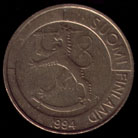Markka
|
|
| Markka | |
|---|---|
 |  |
| 1 Markka 1994 | |
The markka or mark was the currency used in Finland from 1861 until January 1, 1999, when it was replaced by the euro (€). The currency code used for the markka was FIM, and the usual familiar notation was a postfix mk. It was divided into 100 penni. The conversion for one euro was 5.94573 markkaa.
(The Finnish plural forms (strictly speaking, partitive singular forms) of the words "markka" and "penni" are "markkaa" and "penniä".)
The markka was introduced in 1861 as a quarter of the Russian ruble. After Finland gained independence in 1917, the Bank of Finland was founded and the markka was reintroduced as an independent currency backed by gold. The gold standard was abolished in 1940, and the markka suffered heavy inflation during the war years. In 1963 the markka was replaced by the new markka, equivalent to 100 old units.
The name "markka" was based on a medieval unit of weight. Both "markka" and "penni" are loanwords based on the same roots as the German Mark and pfennig.
Although the word "markka" predates the currency by several centuries, the currency was established before being named "markka". A competition was held for its name, and some of the other entries included "sataikko" (meaning "having a hundred parts"), "omena" (apple) and "suomo" (from "Suomi", the Finnish name for Finland).
During the history of the Finnish markka, spanning over 140 years, 28 coins denominated in markka have been minted. The pictorial subjects have changed over the years, but they have all been distinctly Finnish. The Finnish markka is now history, when Finland changed its currency to the euro in 1999 (markka coins and notes were not withdrawn from circulation until 2002).
Portraits in banknotes
This section covers the last design series of the Finnish markka, designed in the 1990s by Finnish designer Erik Bruun.
- 10 markkaa (blue) - Paavo Nurmi (1897–1973), athlete and Olympic winner (note discontinued upon introduction of the 20 markkaa note)
- 20 markkaa (blue/green) - Väinö Linna (1920–1992), author and novelist (note introduced later in the series)
- 50 markkaa (brown) - Alvar Aalto (1898–1976), architect
- 100 markkaa (green) - Jean Sibelius (1865-1957), composer
- 500 markkaa (red) - Elias Lönnrot (1802-1884), historian
- 1000 markkaa (blue/purple) - Anders Chydenius (1729-1803), priest and statesman
The series also included a preliminary design for a 5000 markkaa (red/purple) note, depicting priest and linguist Mikael Agricola, but the note was never officially introduced into use.
Earlier banknotes
The second-to-last banknote design series, introduced in the 1960s, was the first series to depict actual specific persons. These included Juho Kusti Paasikivi on the 10 markkaa note, Elias Lönnrot on the 100 markkaa note and Urho Kekkonen on the 500 markkaa note (introduced later).
Unlike Erik Bruun's series, this series did not depict any other real-life subjects, but only abstract ornaments in addition to the person depictions. A popular joke at the time was to cover all but the right-hand side of Paasikivi's face on the 10 markkaa note, ending up with something resembling a mouse, said to be the only animal illustration in the entire series.
Still older series from the 1920s and 1930s also depicted humans, but these were generic men and women, and did not represent any specific persons. The fact that these men and women were depicted nude caused a minor controversy at the time.
See also: Scandinavian Monetary Union and Euro
External link
- Overview of markka from the BBC (http://news.bbc.co.uk/hi/english/static/in_depth/business/2001/euro_cash/spent_currencies/markka.stm)
Template:PreEuroCurrenciesde:Finnische Markka fr:Markka it:Marco finlandese nl:Markka nb:Finsk mark nn:Finsk mark pl:Marka fińska fi:Markka zh:芬蘭馬克
